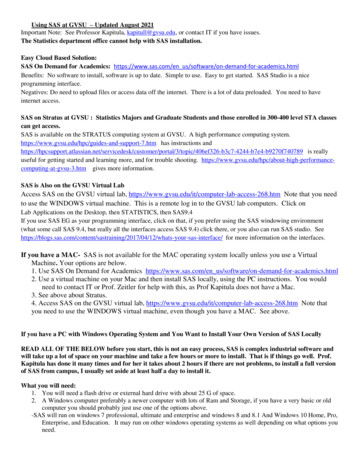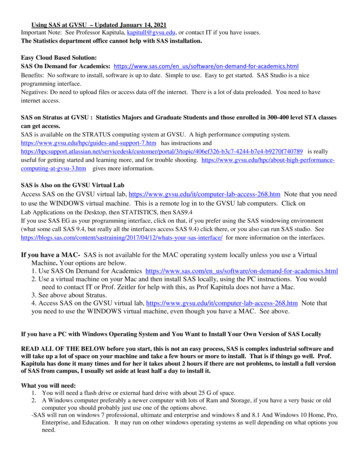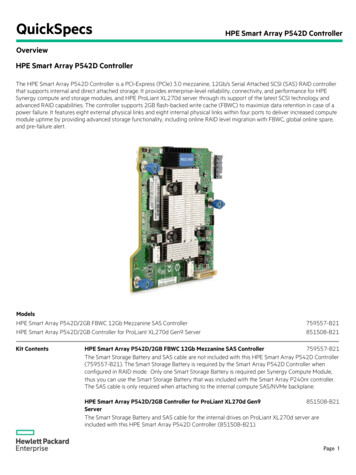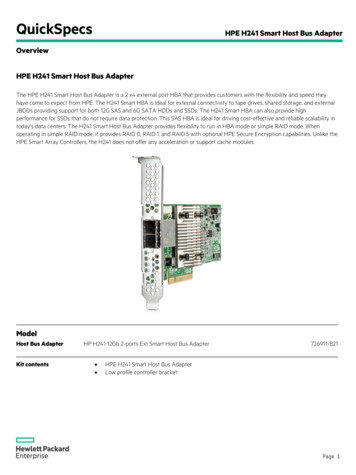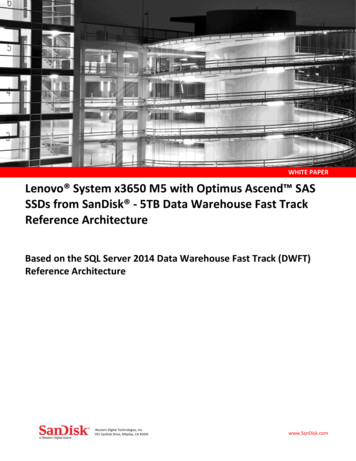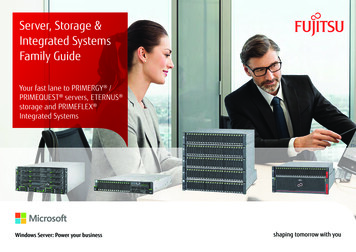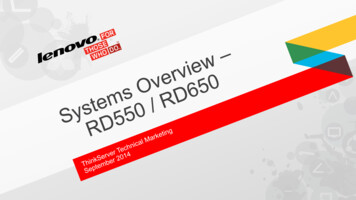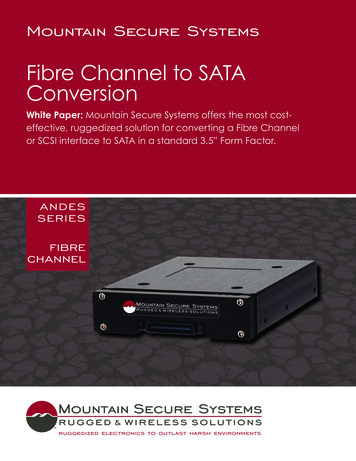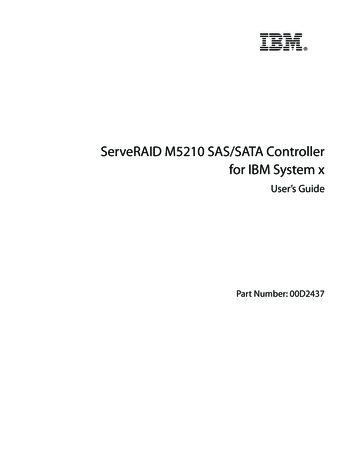
Transcription
ServeRAID M5210 SAS/SATA Controllerfor IBM System xUser’s GuidePart Number: 00D2437
July 2014Third Edition (July 2014) Copyright IBM Corporation 2013.US Government Users Restricted Rights -- Use, duplication or disclosure restricted by GSA ADPSchedule Contract with IBM Corp.
ServeRAID M5210 SAS/SATA Controller for IBM System x User’s GuideJuly 2014SafetySafetyYouq mwngz yungh canjbinj neix gaxgonq, itdingh aeu doeg aencanjbinj soengq cungj vahgangj ancien siusik.Bu ürünü kurmadan önce güvenlik bilgilerini okuyun.-3-
ServeRAID M5210 SAS/SATA Controller for IBM System x User’s GuideJuly 2014Safety-4-
ServeRAID M5210 SAS/SATA Controller for IBM System x User’s GuideJuly 2014Safety-5-
ServeRAID M5210 SAS/SATA Controller for IBM System x User’s GuideJuly 2014SafetyStatement 28:CAUTION:The battery is a lithium ion battery. To avoid possible explosion, do not burn thebattery. Exchange it only with the approved part. Recycle or discard the batteryas instructed by local regulations.-6-
ServeRAID M5210 SAS/SATA Controller for IBM System x User’s GuideJuly 2014Table of ContentsTable of ContentsChapter 1: Overview . . . . . . . . . . . . . . . . . . . . . . . . . . . . . . . . . . . . . . . . . . . . . . . . . . . . . . . . . . . . . . . . . . . . . . . . . . . . . . . . . . . . . . . . . . . . . . . . . . . . . . . . . . . . 31.1 ServeRAID M5210 Controller Description . . . . . . . . . . . . . . . . . . . . . . . . . . . . . . . . . . . . . . . . . . . . . . . . . . . . . . . . . . . . . . . . . . . . . . . . . . . . . . . . . . . . . . . . . . . . .31.1.1 Controller Guidelines . . . . . . . . . . . . . . . . . . . . . . . . . . . . . . . . . . . . . . . . . . . . . . . . . . . . . . . . . . . . . . . . . . . . . . . . . . . . . . . . . . . . . . . . . . . . . . . . . . . . . . . . . 31.2 Integrated MegaRAID Mode and MegaRAID mode . . . . . . . . . . . . . . . . . . . . . . . . . . . . . . . . . . . . . . . . . . . . . . . . . . . . . . . . . . . . . . . . . . . . . . . . . . . . . . . . . . . .41.2.1 Supported RAID Level Upgrades . . . . . . . . . . . . . . . . . . . . . . . . . . . . . . . . . . . . . . . . . . . . . . . . . . . . . . . . . . . . . . . . . . . . . . . . . . . . . . . . . . . . . . . . . . . . . . 41.2.2 Summary of RAID Levels . . . . . . . . . . . . . . . . . . . . . . . . . . . . . . . . . . . . . . . . . . . . . . . . . . . . . . . . . . . . . . . . . . . . . . . . . . . . . . . . . . . . . . . . . . . . . . . . . . . . . . 41.3 Configuration Scenarios . . . . . . . . . . . . . . . . . . . . . . . . . . . . . . . . . . . . . . . . . . . . . . . . . . . . . . . . . . . . . . . . . . . . . . . . . . . . . . . . . . . . . . . . . . . . . . . . . . . . . . . . . . . . . .51.3.1 Number of Physical Disks Supported . . . . . . . . . . . . . . . . . . . . . . . . . . . . . . . . . . . . . . . . . . . . . . . . . . . . . . . . . . . . . . . . . . . . . . . . . . . . . . . . . . . . . . . . . . 61.4 Benefits of the SAS Interface . . . . . . . . . . . . . . . . . . . . . . . . . . . . . . . . . . . . . . . . . . . . . . . . . . . . . . . . . . . . . . . . . . . . . . . . . . . . . . . . . . . . . . . . . . . . . . . . . . . . . . . . . .71.4.1 PCI Express Architecture . . . . . . . . . . . . . . . . . . . . . . . . . . . . . . . . . . . . . . . . . . . . . . . . . . . . . . . . . . . . . . . . . . . . . . . . . . . . . . . . . . . . . . . . . . . . . . . . . . . . . . 71.4.2 Operating System Support . . . . . . . . . . . . . . . . . . . . . . . . . . . . . . . . . . . . . . . . . . . . . . . . . . . . . . . . . . . . . . . . . . . . . . . . . . . . . . . . . . . . . . . . . . . . . . . . . . . . 71.5 Benefits of the ServeRAID M5210 SAS/SATA Controller . . . . . . . . . . . . . . . . . . . . . . . . . . . . . . . . . . . . . . . . . . . . . . . . . . . . . . . . . . . . . . . . . . . . . . . . . . . . . . . .71.5.1 SAS Features . . . . . . . . . . . . . . . . . . . . . . . . . . . . . . . . . . . . . . . . . . . . . . . . . . . . . . . . . . . . . . . . . . . . . . . . . . . . . . . . . . . . . . . . . . . . . . . . . . . . . . . . . . . . . . . . . 81.5.2 SAS Array Limitations . . . . . . . . . . . . . . . . . . . . . . . . . . . . . . . . . . . . . . . . . . . . . . . . . . . . . . . . . . . . . . . . . . . . . . . . . . . . . . . . . . . . . . . . . . . . . . . . . . . . . . . . . 81.5.3 SATA III Features. . . . . . . . . . . . . . . . . . . . . . . . . . . . . . . . . . . . . . . . . . . . . . . . . . . . . . . . . . . . . . . . . . . . . . . . . . . . . . . . . . . . . . . . . . . . . . . . . . . . . . . . . . . . . . 91.5.4 PCI Express Performance. . . . . . . . . . . . . . . . . . . . . . . . . . . . . . . . . . . . . . . . . . . . . . . . . . . . . . . . . . . . . . . . . . . . . . . . . . . . . . . . . . . . . . . . . . . . . . . . . . . . . . 91.5.5 Usability Features. . . . . . . . . . . . . . . . . . . . . . . . . . . . . . . . . . . . . . . . . . . . . . . . . . . . . . . . . . . . . . . . . . . . . . . . . . . . . . . . . . . . . . . . . . . . . . . . . . . . . . . . . . . . 101.5.6 Flexibility Features. . . . . . . . . . . . . . . . . . . . . . . . . . . . . . . . . . . . . . . . . . . . . . . . . . . . . . . . . . . . . . . . . . . . . . . . . . . . . . . . . . . . . . . . . . . . . . . . . . . . . . . . . . . 101.5.7 CacheCade . . . . . . . . . . . . . . . . . . . . . . . . . . . . . . . . . . . . . . . . . . . . . . . . . . . . . . . . . . . . . . . . . . . . . . . . . . . . . . . . . . . . . . . . . . . . . . . . . . . . . . . . . . . . . . . . . . 101.5.8 Protection Information (T10-DIF) . . . . . . . . . . . . . . . . . . . . . . . . . . . . . . . . . . . . . . . . . . . . . . . . . . . . . . . . . . . . . . . . . . . . . . . . . . . . . . . . . . . . . . . . . . . . . 101.5.9 Drive Roaming . . . . . . . . . . . . . . . . . . . . . . . . . . . . . . . . . . . . . . . . . . . . . . . . . . . . . . . . . . . . . . . . . . . . . . . . . . . . . . . . . . . . . . . . . . . . . . . . . . . . . . . . . . . . . . 111.5.10 Drive Migration . . . . . . . . . . . . . . . . . . . . . . . . . . . . . . . . . . . . . . . . . . . . . . . . . . . . . . . . . . . . . . . . . . . . . . . . . . . . . . . . . . . . . . . . . . . . . . . . . . . . . . . . . . . . 121.5.11 New Drives Attached to a ServeRAID Controller . . . . . . . . . . . . . . . . . . . . . . . . . . . . . . . . . . . . . . . . . . . . . . . . . . . . . . . . . . . . . . . . . . . . . . . . . . . . . 121.5.12 Automatic Rebuilds on New Drives. . . . . . . . . . . . . . . . . . . . . . . . . . . . . . . . . . . . . . . . . . . . . . . . . . . . . . . . . . . . . . . . . . . . . . . . . . . . . . . . . . . . . . . . . . 131.5.13 System (JBOD) Drives . . . . . . . . . . . . . . . . . . . . . . . . . . . . . . . . . . . . . . . . . . . . . . . . . . . . . . . . . . . . . . . . . . . . . . . . . . . . . . . . . . . . . . . . . . . . . . . . . . . . . . . 131.6 Hardware Specifications. . . . . . . . . . . . . . . . . . . . . . . . . . . . . . . . . . . . . . . . . . . . . . . . . . . . . . . . . . . . . . . . . . . . . . . . . . . . . . . . . . . . . . . . . . . . . . . . . . . . . . . . . . . . .131.7 Technical Support. . . . . . . . . . . . . . . . . . . . . . . . . . . . . . . . . . . . . . . . . . . . . . . . . . . . . . . . . . . . . . . . . . . . . . . . . . . . . . . . . . . . . . . . . . . . . . . . . . . . . . . . . . . . . . . . . . .14Chapter 2: ServeRAID M5210 SAS/SATA Controller for IBM System x User’s Guide . . . . . . . . . . . . . . . . . . . . . . . . . . . . . . . . . . . . . . . . . . . . . . . . . 152.1 Requirements . . . . . . . . . . . . . . . . . . . . . . . . . . . . . . . . . . . . . . . . . . . . . . . . . . . . . . . . . . . . . . . . . . . . . . . . . . . . . . . . . . . . . . . . . . . . . . . . . . . . . . . . . . . . . . . . . . . . . . .152.2 Hardware installation . . . . . . . . . . . . . . . . . . . . . . . . . . . . . . . . . . . . . . . . . . . . . . . . . . . . . . . . . . . . . . . . . . . . . . . . . . . . . . . . . . . . . . . . . . . . . . . . . . . . . . . . . . . . . . .152.3 Connecting a ServeRAID M5210 SAS/SATA Controller to a Drive Backplane on an Enclosure . . . . . . . . . . . . . . . . . . . . . . . . . . . . . . . . . . . . . . . . . . .172.4 After Installing the Controller . . . . . . . . . . . . . . . . . . . . . . . . . . . . . . . . . . . . . . . . . . . . . . . . . . . . . . . . . . . . . . . . . . . . . . . . . . . . . . . . . . . . . . . . . . . . . . . . . . . . . . . .18Chapter 3: ServeRAID M5210 SAS/SATA Controller Characteristics . . . . . . . . . . . . . . . . . . . . . . . . . . . . . . . . . . . . . . . . . . . . . . . . . . . . . . . . . . . . . . . . 193.1 Board Layout and Connector Information . . . . . . . . . . . . . . . . . . . . . . . . . . . . . . . . . . . . . . . . . . . . . . . . . . . . . . . . . . . . . . . . . . . . . . . . . . . . . . . . . . . . . . . . . . . .193.2 Characteristics of the ServeRAID M5210 SAS/SATA Controller. . . . . . . . . . . . . . . . . . . . . . . . . . . . . . . . . . . . . . . . . . . . . . . . . . . . . . . . . . . . . . . . . . . . . . . . .213.2.1 Controller Specifications . . . . . . . . . . . . . . . . . . . . . . . . . . . . . . . . . . . . . . . . . . . . . . . . . . . . . . . . . . . . . . . . . . . . . . . . . . . . . . . . . . . . . . . . . . . . . . . . . . . . . 213.2.2 Array Performance Features. . . . . . . . . . . . . . . . . . . . . . . . . . . . . . . . . . . . . . . . . . . . . . . . . . . . . . . . . . . . . . . . . . . . . . . . . . . . . . . . . . . . . . . . . . . . . . . . . . 223.2.3 Fault Tolerance . . . . . . . . . . . . . . . . . . . . . . . . . . . . . . . . . . . . . . . . . . . . . . . . . . . . . . . . . . . . . . . . . . . . . . . . . . . . . . . . . . . . . . . . . . . . . . . . . . . . . . . . . . . . . . 233.2.4 Power Supply Requirements for the ServeRAID M5210 SAS/SATA Controller . . . . . . . . . . . . . . . . . . . . . . . . . . . . . . . . . . . . . . . . . . . . . . . . . . . 233.2.5 Operating and Non-operating Conditions . . . . . . . . . . . . . . . . . . . . . . . . . . . . . . . . . . . . . . . . . . . . . . . . . . . . . . . . . . . . . . . . . . . . . . . . . . . . . . . . . . . . 233.2.6 Safety Characteristics . . . . . . . . . . . . . . . . . . . . . . . . . . . . . . . . . . . . . . . . . . . . . . . . . . . . . . . . . . . . . . . . . . . . . . . . . . . . . . . . . . . . . . . . . . . . . . . . . . . . . . . . 23Appendix A: Getting Help and Technical Assistance . . . . . . . . . . . . . . . . . . . . . . . . . . . . . . . . . . . . . . . . . . . . . . . . . . . . . . . . . . . . . . . . . . . . . . . . . . . . . . 24A.1 Before You Call . . . . . . . . . . . . . . . . . . . . . . . . . . . . . . . . . . . . . . . . . . . . . . . . . . . . . . . . . . . . . . . . . . . . . . . . . . . . . . . . . . . . . . . . . . . . . . . . . . . . . . . . . . . . . . . . . . . . .24A.2 Using the Documentation . . . . . . . . . . . . . . . . . . . . . . . . . . . . . . . . . . . . . . . . . . . . . . . . . . . . . . . . . . . . . . . . . . . . . . . . . . . . . . . . . . . . . . . . . . . . . . . . . . . . . . . . . .24A.3 Getting Help and Information from the World Wide Web . . . . . . . . . . . . . . . . . . . . . . . . . . . . . . . . . . . . . . . . . . . . . . . . . . . . . . . . . . . . . . . . . . . . . . . . . . . .25-1-
ServeRAID M5210 SAS/SATA Controller for IBM System x User’s GuideJuly 2014Table of ContentsA.4 Software Service and Support . . . . . . . . . . . . . . . . . . . . . . . . . . . . . . . . . . . . . . . . . . . . . . . . . . . . . . . . . . . . . . . . . . . . . . . . . . . . . . . . . . . . . . . . . . . . . . . . . . . . . . .25A.5 Hardware Service and Support . . . . . . . . . . . . . . . . . . . . . . . . . . . . . . . . . . . . . . . . . . . . . . . . . . . . . . . . . . . . . . . . . . . . . . . . . . . . . . . . . . . . . . . . . . . . . . . . . . . . . .25A.6 IBM Taiwan Product Service . . . . . . . . . . . . . . . . . . . . . . . . . . . . . . . . . . . . . . . . . . . . . . . . . . . . . . . . . . . . . . . . . . . . . . . . . . . . . . . . . . . . . . . . . . . . . . . . . . . . . . . . .25Appendix B: Notices . . . . . . . . . . . . . . . . . . . . . . . . . . . . . . . . . . . . . . . . . . . . . . . . . . . . . . . . . . . . . . . . . . . . . . . . . . . . . . . . . . . . . . . . . . . . . . . . . . . . . . . . . . . 26B.1 Trademarks . . . . . . . . . . . . . . . . . . . . . . . . . . . . . . . . . . . . . . . . . . . . . . . . . . . . . . . . . . . . . . . . . . . . . . . . . . . . . . . . . . . . . . . . . . . . . . . . . . . . . . . . . . . . . . . . . . . . . . . .27B.2 Important Notes . . . . . . . . . . . . . . . . . . . . . . . . . . . . . . . . . . . . . . . . . . . . . . . . . . . . . . . . . . . . . . . . . . . . . . . . . . . . . . . . . . . . . . . . . . . . . . . . . . . . . . . . . . . . . . . . . . . .27B.3 Documentation Format . . . . . . . . . . . . . . . . . . . . . . . . . . . . . . . . . . . . . . . . . . . . . . . . . . . . . . . . . . . . . . . . . . . . . . . . . . . . . . . . . . . . . . . . . . . . . . . . . . . . . . . . . . . . .28B.4 Electronic Emission Notices . . . . . . . . . . . . . . . . . . . . . . . . . . . . . . . . . . . . . . . . . . . . . . . . . . . . . . . . . . . . . . . . . . . . . . . . . . . . . . . . . . . . . . . . . . . . . . . . . . . . . . . . .28-2-
ServeRAID M5210 SAS/SATA Controller for IBM System x User’s GuideJuly 2014Chapter 1: OverviewServeRAID M5210 Controller DescriptionChapter 1: Overview1.1ServeRAID M5210 Controller DescriptionThe ServeRAID M5210 SAS/SATA controller is a PCI-Express 3.0, half-size, half-height RAID controller based on theLSISAS3108 PCI Express-SAS/SATA I/O Processor chip.The controller controls eight internal SAS/SATA ports through two SFF-8643 4i internal mini-SAS HD connectors. Thecontroller integrates eight high-performance SAS/SATA PHYs and a PCI Express bus master DMA core. Each of theeight PHYs is capable of 12.0 Gb/s SAS link rates and 6.0 Gb/s SATA III link rates.The controller brings 12.0 Gb/s SAS and 6.0 Gb/s SATA performance to host controller, workstation, and server designs.The controller supports internal storage devices, which allows you to use a system that supports enterprise-class SASdrives, and desktop-class SATA drives. The controller can connect to drives directly. Simplified cabling betweendevices is an additional benefit.The LSISAS3108 ROC device increases system performance and provides fault-tolerant data storage. The LSISAS3108supports data striping across multiple disks, which reduces disk access time because multiple disks simultaneouslyread or write data. In addition, the LSISAS3108 ROC device backs up data with either data mirroring or a parity block.Either backup method enables you to recover lost data in the event of a disk failure. You can select the data backupmethod that best suits your needs. A hardware RAID assist exclusive-OR (XOR) engine speeds parity generation andchecking and reduces system-access times.The controller supports the SAS protocol as described in the Serial Attached SCSI Standard, version 3.0, and the SATAIII protocol defined by the Serial ATA Revision 3.0 Specification.NOTE You cannot mix SAS drives and SATA drives within the same virtual drive.Each port on the controller supports SAS devices and/or SATA devices using the following: 1.1.1SAS Serial SCSI Protocol (SSP), which enables communication with other SAS devicesSATA, which enables communication with other SATA devicesSerial Management Protocol (SMP), which communicates topology management information directly with anattached SAS expander deviceSerial Tunneling Protocol (STP), which enables communication with a SATA device through an attached expanderController Guidelinesbefore you install the controller, read the following guidelines: You can connect only one device per SAS PHY unless you use an expanderCables have to meet the SAS specificationYou cannot mix SAS drives and SATA drives in the same virtual driveYou cannot mix SAS Solid State Drives (SSDs) or SATA SSDs and existing mechanical drives (SAS or SATA) in thesame virtual driveYou cannot mix Solid State SAS drives and Solid State SATA drives in the same virtual driveSee Section 3.2.4, “Power Supply Requirements for the ServeRAID M5210 SAS/SATA Controller” for information aboutthe power requirements, and Section 3.2.5, “Operating and Non-operating Conditions”for information about theminimum and the maximum temperature ranges.-3-
ServeRAID M5210 SAS/SATA Controller for IBM System x User’s GuideJuly 20141.2Chapter 1: OverviewIntegrated MegaRAID Mode and MegaRAID modeIntegrated MegaRAID Mode and MegaRAID modeThe ServeRAID M5210 controller can run in either integrated MegaRAID (iMR) mode natively or in MegaRAID (MR)mode with the addition of a transportable memory module.iMR is a highly integrated, low-cost RAID solution made possible by Fusion-MPT architecture. Integrated MegaRAID isa processor-based, hardware RAID solution designed for system environments requiring redundancy and highavailability where a full-featured RAID implementation is not required or might be cost prohibitive.The major advantage of iMR is that it provides RAID at the processor level, so it does not burden the CPU, which allowsfor more efficient operation. iMR mode is native to the ServeRAID M5210 controller and does not require atransportable memory module.The major advantage of MR mode is that the it supports more RAID levels than iMR mode. iMR mode supports RAIDlevels 0, 1, 5, 10, and 50 and supports 64k stripe size only. MR mode supports RAID levels 0, 1, 5, 6, 10, 50, and 60 andsupports 64k to 1M stripe size.NOTE iMR mode RAID 5 requires purchase of the Feature on Demand upgrade.NOTE MR mode RAID 5/50 requires a transportable memory module (4 options).NOTE MegaRAID RAID 6/60 requires a transportable memory module (4 options) and the Feature on Demandupgrade.See Section 1.2.1, “Supported RAID Level Upgrades” for information about these upgrades.See Section 1.2.2, “Summary of RAID Levels” for information about the supported RAID levels.1.2.1Supported RAID Level UpgradesTo use RAID levels 5, 6, 50, or 60 with this controller, you need to install a Feature on Demand upgrade and/or atransportable memory module, depending on the RAID level.This controller supports iMR RAID levels 5 and 50 with the following installed Feature on Demand upgrade: ServeRAID M5200 Series Zero Cache/RAID 5 Upgrade for IBM System xThis controller supports MegaRAID RAID levels 5 and 50, with any of the following installed transportable memorymodules: ServeRAID M5200 Series 1GB Cache/RAID 5 Upgrade for IBM System xServeRAID M5200 Series 1GB Flash/RAID 5 Upgrade for IBM System xServeRAID M5200 Series 2GB Flash/RAID 5 Upgrade for IBM System xServeRAID M5200 Series 4GB Flash/RAID 5 Upgrade for IBM System xThis controller supports MegaRAID RAID levels 6 and 60 with the ServeRAID M5200 Series RAID 6 Upgrade for IBMSystem x1.2.2Summary of RAID LevelsRAID levels describe a system for ensuring the availability and redundancy of data stored on large disk subsystems.-4-
ServeRAID M5210 SAS/SATA Controller for IBM System x User’s GuideJuly 2014Chapter 1: OverviewConfiguration ScenariosRAID 0 uses striping to provide high data throughput, especially for large files in an environment that does not requirefault tolerance.RAID 1 uses mirroring so that data written to one drive is simultaneously written to another drive. This is good forsmall databases or other applications that require small capacity but complete data redundancy.RAID 5 uses disk striping and parity data across all drives (distributed parity) to provide high data throughput,especially for small random access.RAID 6 uses distributed parity, with two independent parity blocks per stripe, and disk striping. A RAID 6 virtual drivecan survive the loss of two drives without losing data. A RAID 6 drive group, which requires a minimum of three drives,is similar to a RAID 5 drive group. Blocks of data and parity information are written across all drives. The parityinformation is used to recover the data if one or two drives fail in the drive group.RAID 10, a combination of RAID 0 and RAID 1, consists of striped data across mirrored spans. A RAID 10 drive group isa spanned drive group that creates a striped set from a series of mirrored drives. RAID 10 allows a maximum of eightspans. You must use an even number of drives in each RAID virtual drive in the span. The RAID 1 virtual drives musthave the same stripe size. RAID 10 provides high data throughput and complete data redundancy but uses a largernumber of spans.RAID 50, a combination of RAID 0 and RAID 5, uses distributed parity and disk striping. A RAID 50 drive group is aspanned drive group in which data is striped across multiple RAID 5 drive groups. RAID 50 works best with data thatrequires high reliability, high request rates, high data transfers, and medium-to-large capacity.RAID 60, a combination of RAID 0 and RAID 6, uses distributed parity, with two independent parity blocks per stripe ineach RAID set, and disk striping. A RAID 60 virtual drive can survive the loss of two drives in each of the RAID 6 setswithout losing data. It works best with data that requires high reliability, high request rates, high data transfers, andmedium-to-large capacity.NOTE Having virtual drives of different RAID levels, such as RAID 0 and RAID 5, in the same drive group is notallowed. For example, if an existing RAID 5 virtual drive is created out of partial space in an array, the nextvirtual drive in the array has to be RAID 5 only.1.3Configuration ScenariosThere are two main scenarios in which you can use this ServeRAID controller: Low-end, internal SATA configuration: In this configuration, use the ServeRAID controller as a high-end SATAcompatible controller that connects to several SATA disks. This type of configuration is mostly for low-end or entrylevel servers. Enclosure management is provided through out-of-band I2C bus. Side bands of both types ofinternal SAS connectors support the SFF-8485 and SFF-8448 (SGPIO) interface.Midrange, internal SAS configuration: This configuration is like the internal SATA configuration, but with high-enddisks. This type of configuration is more suitable for low-range to midrange servers.The following figure shows a direct-connect configuration. The Inter-IC (I2C) interface communicates with peripherals.The external memory bus provides a 32-bit memory bus, parity checking, and chip select signals for pipelinedsynchronous burst static random access memory (PSBRAM), nonvolatile static random access memory (NVSRAM), andFlash ROM.-5-
ServeRAID M5210 SAS/SATA Controller for IBM System x User’s GuideJuly 2014Chapter 1: OverviewConfiguration ScenariosFigure 1 Example of a SAS Direct Connect ApplicationSAS/SATA III DeviceSASPCI ExpressRAID ControllerSAS/SATA III DeviceSAS/SATA III Device32-Bit MemoryAddress/DataBusI 2CInterfaceFlash ROM/PSBRAM/NVSRAMI2 CSAS/SATA III DevicePCI Express InterfaceThe following figure shows an example of a ServeRAID controller configured with an expander that is connected toSAS disks, SATA disks, or both.Figure 2 Example of a ServeRAID Controller Configured with an ExpanderPCI Express Interface8SAS RAID ControllerPCI Express to SAS ROCPeripheralBus72-bit DDR/DDR2with ECCInterfaceFlash 1Number of Physical Disks SupportedYour configuration planning for your ServeRAID controller depends in part on the number of physical disks that youwant to use in a RAID array. The number of drives in an array determines the RAID levels that can be supported by thiscontroller. Only one RAID level can be assigned to each virtual disk. Table 1 shows the minimum number and themaximum number of drives required for each RAID level.Table 1 Physical Devices Required for each RAID LevelRaid LevelMinimum # ofMaximum # ofPhysical Devices Physical Devices013212253326332104325063260632-6-
ServeRAID M5210 SAS/SATA Controller for IBM System x User’s GuideJuly 20141.4Chapter 1: OverviewBenefits of the SAS InterfaceBenefits of the SAS InterfaceSAS is a serial, point-to-point, enterprise-level device interface that leverages the proven SCSI protocol set. SAScombines the advantages of SATA, SCSI, and Fibre Channel, and is the future mainstay of the enterprise and high-endworkstation storage markets. SAS offers a higher bandwidth per pin than parallel SCSI, and it improves signal and dataintegrity.The SAS interface uses the proven SCSI command set to ensure reliable data transfers, while providing theconnectivity and flexibility of point-to-point serial data transfers. The serial transmission of SCSI commands eliminatesclock-skew challenges. The SAS interface provides improved performance, simplified cabling, smaller connectors,lower pin count, and lower power requirements when compared to parallel SCSI.The ServeRAID M5210 SAS/SATA controller leverages a common electrical and physical connection interface that iscompatible with Serial ATA technology. The SAS protocols and SATA protocols use a thin, 7-wire connector instead ofthe 68-wire SCSI cable or 26-wire ATA cable. The SAS/SATA III connector and cable are easier to manipulate, allowconnections to smaller devices, and do not inhibit airflow. The point-to-point SATA III architecture eliminates inherentdifficulties created by the legacy ATA master-slave architecture, while maintaining compatibility with existing ATAfirmware.1.4.1PCI Express ArchitecturePCI Express is a local bus system designed to increase data transfers without slowing down the central processing unit(CPU). You can install your ServeRAID M5210SAS/SATA controller in PCI Express computer systems with a standardbracket type. With this controller in your system, you can connect SCSI devices and SATA devices over the bus.PCI Express goes beyond the PCI specification in that it is intended as a unifying I/O architecture for various systems:desktops, workstations, mobile, server, communications, and embedded devices.1.4.2Operating System SupportTo check for the latest list of supported operating systems and to download the device drivers for those operatingsystems, see http://www.ibm.com/systems/support/.The ServeRAID M5210 controller uses Fusion-MPT architecture for all major operating systems, thinner device drivers,and better performance.1.5Benefits of the ServeRAID M5210 SAS/SATA ControllerThis section provides a summary of the features and the benefits of the ServeRAID M5210 SAS/SATA controller. Itcontains information on SAS features, SATA features, PCI performance, integration, usability, and flexibility.The controller offers the following features: PCI Express x8 lane widthPCI Express performance up to 8 GT/s (1 GB/s) per laneTwo internal connectorsSupport for RAID levels 0, 1, 5, 10, and 50 in iMR modeSupport for RAID levels 0, 1, 5, 6, 10, 50, and 60 in MR modeTo use RAID levels 5/50/6/60 with this controller, you need to install a Feature on Demand upgrade and/or atransportable memory module. See Section 1.2.1, “Supported RAID Level Upgrades” for information about theseupgrades.-7-
ServeRAID M5210 SAS/SATA Controller for IBM System x User’s GuideJuly 2014 1.5.1Chapter 1: OverviewBenefits of the ServeRAID M5210 SAS/SATA ControllerAdvanced array configuration and management utilitiesOnline RAID level migrationDrive migrationDrive roamingMedia scanNo reboot necessary after expansionMore than 200 Qtags per arrayUser-specified rebuild rate32-Kbyte nonvolatile random access memory (NVRAM) for storing RAID system configuration information; theMegaRAID SAS firmware is stored in flash ROM for easy upgrade.SAS FeaturesThe following list describes the SAS features of the ServeRAID M5210 controller: 1.5.2Provides eight fully independent PHYsSupports 12.0 Gb/s SAS data transfers per PHYSupports SSP to enable communication with other SAS devicesSupports SMP to communicate topology management informationProvides a serial, point-to-point, enterprise-level storage interfaceSimplifies cabling between devicesSupports wide ports consisting of 2, 3, or 4 PHYs within a single quad portSupports narrow ports consisting of a single PHYTransfers data using SCSI information unitsSAS Array LimitationsThis section describes the array limitations of the controller. These include limitations such as the number of physicaldisks supported, the maximum number of disks per controller, and the maximum number of virtual disks allowed percontroller.Table 2 lists the array limitations for the ServeRAID M5210 controller.Table 2 ServeRAID M5210 SAS/SATA Controller ArraySpecificationServeRAID M5210SAS/SATA ControllerMaximum virtual disks per controller64Maximum arrays per controller128Maximum virtual disks per array16Maximum physical devices per array32Maximum physical devices per controller128NOTE Can support upto 64 devices, but only16 can be used in aRAID configuration.-8-
ServeRAID M5210 SAS/SATA Controller for IBM System x User’s GuideJuly 2014Chapter 1: OverviewBenefits of the ServeRAID M5210 SAS/SATA ControllerTable 2 ServeRAID M5210 SAS/SATA Controller ArraySpecificationMaximum hot spares per controllerServeRAID M5210SAS/SATA Controller128Maximum spans per virtual disk8Maximum Ports2NOTE The maximum number of hot spares per array is equal to the maximum number of device drivers perarray.The controller supports 64-bit logical block addressing (LBA), which makes it possible to connect a large number ofdrives to the RAID controller, directly and through expanders. However, the actual number of drives that you canattach depends on the limits listed in Table 1 rather than by the actual RAID volume capacity.The maximum drive numbers in Table 2 depend on how many phy
The LSISAS3108 ROC device increases system performance and provides fault-tolerant data storage. The LSISAS3108 supports data striping across multiple disks, which reduce s disk access time because multiple disks simultaneously read or write data. In addition, the LSISAS3108 ROC device backs up data with either data mirroring or a parity block.
